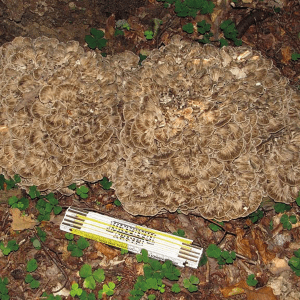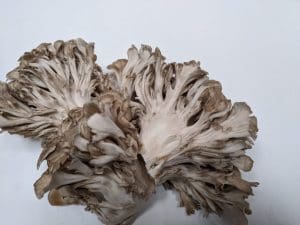Hen of the Woods / Summer / Autumn / Edible
Indulge in the delightful flavors of the Hen of the Woods (Grifola frondosa) as we embark on a culinary adventure celebrating this prized mushroom.
Join us in savoring the unique delights offered by nature’s bountiful creation. With its striking frilly appearance and earthy charm, the Hen of the Woods stands as a true culinary gem.
Learn to identify its distinctive features, explore its preferred habitats, and delve into the culinary wonders it bestows. From its meaty texture to its rich, umami flavor, this mushroom has the power to elevate your dishes to extraordinary heights.
Whether you are an experienced forager or a passionate home cook, let the Hen of the Woods inspire your culinary creations and tantalize your taste buds with its marvelous flavors. Embrace the abundance of nature’s bounty as we celebrate the enchanting delights that lie within the Hen of the Woods. Get ready to embark on a flavor-filled journey as we explore the captivating culinary possibilities offered by this extraordinary fungus.
Botanical Name
grifola frondosa
Also Known as
Ram’s head, Sheep’s head, Maitake
Range and Distribution
This fungus is found from Europe to China and in Eastern parts of Canada and the US. It is highly prized, and its Japanese name, Maitake, means ‘dancing mushroom’. We certainly dance with excitement when we find one!
Habitat
This fungus typically grows around the bases of mature Oak trees or more rarely on other deciduous species. It forms clusters on trunks or sometimes on the ground nearby where it springs up from the roots of the tree. It is parasitic on the tree and will often come back year after year in the same spot.
Physical Characteristics of Hen of the Woods
Looks: This fungus grows clusters of small frilly brackets, forming a clump that looks a bit like a brown cauliflower from a distance, or like feathers, hence its name.
The middle of the clump is whitish and has a branching structure, which divides into many individual lobes or brackets. These can be 2-10cm across, and 1-3mm thick, firm but flexible with wavy rounded edges and soft varying shades of greyish brown that add to the feathery appearance.
The underside of each bracket is cream and covered in tiny holes or pores that release cream coloured spores as they mature. The flesh is creamy buff white, and firm.
Taste/smell: Pleasantly mushroomy smell and taste when young, strengthened by drying. it can get quite acrid as it gets old and starts decaying.
dark brown above, cream below.
Edible Use:
The whole fruiting body is edible, prized for its rich mushroom taste, and has a firm texture. The very base of the brackets can be a little tough, so you can discard that if so. And all those frills make perfect hiding places for bugs and beasties, so check as you pull the fronds apart and wash it thoroughly! It is used widely in Japan, where it is known as Maitake.
It can be fried, roasted, dried and used for flavouring or stewed down to make a sauce or stock . In fact, it can be substituted in to pretty much any mushroom dish – or like many wild mushrooms it can be heavenly simply fried in butter and enjoyed on toast with a twist of salt and pepper.
As with any mushroom, make sure to cook it thoroughly and try a little bit first if you haven’t had it before to avoid stomach upsets.
Medicine
Maitake is traditionally rumoured to have a great many medicinal uses. It is thought to boost the immune system, help with Polycystic Ovarian Syndrome and some cancers, although evidence from clinical trials is lacking. It may also lower blood sugar, so seek advice before taking it as a supplement if you are on diabetes medication.
Known Hazards
Like with any wild mushroom it is possible to be allergic to it or have some tummy trouble if it is undercooked. To reduce the chances of a bad time try a small amount first if you haven’t had it before, and cook thoroughly
Harvesting
Generally considered an autumnal mushroom, look out for it from late August to November
Could be Confused With
Cauliflower Fungus (Sparassis spathulata) forms similar frilly clumps, but is much paler and if anything even more frilly.
Blackening Polypore (Melipilus Giganteus) has much larger, thicker brackets that are rounded and fan shaped rather than divided into lots of frills. It is typically a browner shade and quickly bruises black when cut or handled.
Both of these potential lookalikes are edible
Tips and Observations
As it can be a very similar shade of grey brown to the bark of the oak rrees it grows on, you could easily walk past without spotting this. Take your time around big, old trees and keep your eyes peeled for its fluffy shape







